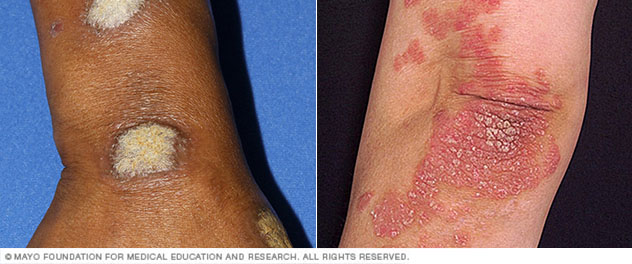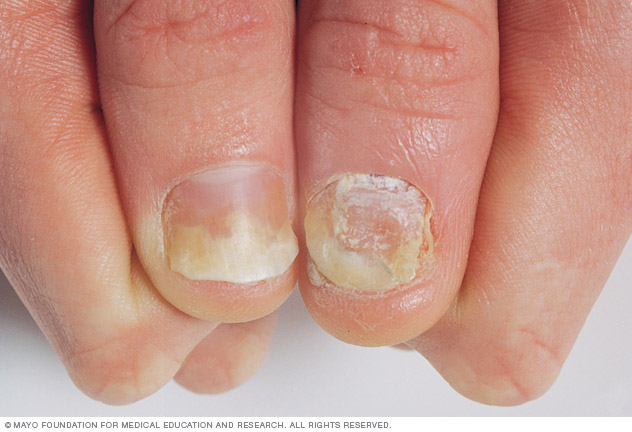Psoriatic arthritis is a form of arthritis that affects some people who have psoriasis — a disease that causes red patches of skin topped with silvery scales. Most people develop psoriasis years before being diagnosed with psoriatic arthritis. But for some, the joint problems begin before skin patches appear or at the same time.
Joint pain, stiffness and swelling are the main signs and symptoms of psoriatic arthritis. They can affect any part of the body, including your fingertips and spine, and can range from relatively mild to severe. In both psoriasis and psoriatic arthritis, disease flares can alternate with periods of remission.
There's no cure for psoriatic arthritis. Treatment is aimed at controlling symptoms and preventing joint damage. Without treatment, psoriatic arthritis can be disabling.

Plaque psoriasis is the most common type of psoriasis. It usually causes dry, red skin lesions (plaques) covered with silvery scales.
Symptoms
Both psoriatic arthritis and psoriasis are chronic diseases that worsen over time. However, you might have periods when your symptoms improve or go away temporarily.
Psoriatic arthritis can affect joints on one or both sides of your body. The signs and symptoms of psoriatic arthritis often resemble those of rheumatoid arthritis. Both diseases cause joints to become painful, swollen and warm to the touch.
However, psoriatic arthritis is more likely to also cause:
- Swollen fingers and toes. Psoriatic arthritis can cause a painful, sausage-like swelling of your fingers and toes.
- Foot pain. Psoriatic arthritis can also cause pain at the points where tendons and ligaments attach to your bones — especially at the back of your heel (Achilles tendinitis) or in the sole of your foot (plantar fasciitis).
- Lower back pain. Some people develop a condition called spondylitis as a result of psoriatic arthritis. Spondylitis mainly causes inflammation of the joints between the vertebrae of your spine and in the joints between your spine and pelvis (sacroiliitis).
- Nail changes. Nails can form tiny dents (pits), crumble or separate from the nail beds.
- Eye inflammation. Uveitis can cause eye pain, redness and blurry vision. If untreated, uveitis can lead to vision loss.
When to see a doctor
If you have psoriasis, tell your doctor if you develop joint pain. Psoriatic arthritis can severely damage your joints if left untreated.
Causes
Psoriatic arthritis occurs when your body's immune system attacks healthy cells and tissue. The immune response causes inflammation in your joints as well as overproduction of skin cells.
It seems likely that both genetic and environmental factors play a role in this immune system response. Many people with psoriatic arthritis have a family history of either psoriasis or psoriatic arthritis. Researchers have discovered certain genetic markers that appear to be associated with psoriatic arthritis.
Physical trauma or something in the environment — such as a viral or bacterial infection — might trigger psoriatic arthritis in people with an inherited tendency.
Risk factors
Several factors can increase your risk of psoriatic arthritis, including:
- Psoriasis. Having psoriasis is the single greatest risk factor for developing psoriatic arthritis.
- Family history. Many people with psoriatic arthritis have a parent or a sibling with the disease.
- Age. Although anyone can develop psoriatic arthritis, it occurs most often in adults between the ages of 30 and 55.

In some cases, psoriasis can cause pitted and deformed nails that are thickened and discolored. Nails may also separate from the nail bed.
Complications
A small percentage of people with psoriatic arthritis develop arthritis mutilans — a severe, painful and disabling form of psoriatic arthritis. Over time, arthritis mutilans destroys the small bones in the hands, especially the fingers, leading to permanent deformity and disability.
Psoriatic arthritis also puts some people at higher risk of developing hypertension, metabolic syndrome, diabetes and cardiovascular disease
Diagnosis
During the exam, your doctor might:
- Examine your joints for signs of swelling or tenderness
- Check your fingernails for pitting, flaking and other abnormalities
- Press on the soles of your feet and around your heels for to check for tender areas
No single test can confirm a diagnosis of psoriatic arthritis. But some types of tests can rule out other causes of joint pain, such as rheumatoid arthritis or gout.
Imaging tests
- X-rays. These can help pinpoint changes in the joints that occur in psoriatic arthritis but not in other arthritic conditions.
- MRI. This uses radio waves and a strong magnetic field to produce detailed images of both hard and soft tissues in your body. MRI can be used to check for problems with the tendons and ligaments in your feet and lower back.
Laboratory tests
- Rheumatoid factor (RF). RF is an antibody that's often present in the blood of people with rheumatoid arthritis but not usually in the blood of people with psoriatic arthritis. This test can help your doctor distinguish between the two conditions.
- Joint fluid test. Using a needle, the doctor can remove a small sample of fluid from one of your affected joints — often the knee. Uric acid crystals in your joint fluid might indicate that you have gout rather than psoriatic arthritis. It's also possible to have both gout and psoriatic arthritis.
Treatment
No cure exists for psoriatic arthritis. Treatment focuses on controlling inflammation in your affected joints to prevent joint pain and disability and controlling skin involvement. One of the most common treatments are prescription medications called disease-modifying antirheumatic drugs (DMARDs).
Treatment will depend on how severe your disease is and what joints are affected. You might have to try different treatments before you find one that brings you relief.
Medications
Drugs used to treat psoriatic arthritis include:
- NSAIDs. Nonsteroidal anti-inflammatory drugs (NSAIDs) can relieve pain and reduce inflammation for people with mild psoriatic arthritis. NSAIDs available without a prescription include ibuprofen (Advil, Motrin IB, others) and naproxen sodium (Aleve). Stronger NSAIDs are available by prescription. Side effects can include stomach irritation, heart problems, and liver and kidney damage.
-
Conventional DMARDs. These drugs can slow the progression of psoriatic arthritis and save joints and other tissues from permanent damage.
The most commonly used DMARD is methotrexate (Trexall, Otrexup, others). Others include leflunomide (Arava) and sulfasalazine (Azulfidine). Side effects can include liver damage, bone marrow suppression, and lung inflammation and scarring (fibrosis).
- Biologic agents. Also known as biologic response modifiers, this class of DMARD targets different pathways of the immune system. Biologic agents include adalimumab (Humira), certolizumab (Cimzia), etanercept (Enbrel), golimumab (Simponi), infliximab (Remicade), ustekinumab (Stelara), secukinumab (Cosentyx), ixekizumab (Taltz), guselkumab (Tremfya) and abatacept (Orencia). These drugs can increase the risk of infections.
- Targeted synthetic DMARDs. Tofacitinib (Xeljanz) might be used if conventional DMARDs and biologic agents haven't been effective. Higher doses of tofacitinib can increase the risk of blood clots in the lungs, serious heart-related events and cancer.
- Newer oral medication. Apremilast (Otezla) decreases the activity of an enzyme in the body that controls the activity of inflammation within cells. Apremilast is used for people with mild to moderate psoriatic arthritis who do not want or cannot be treated with DMARDs or biologic agents. Potential side effects include diarrhea, nausea and headaches.
Therapies
Physical and occupational therapies might ease pain and make it easier to do everyday tasks. Ask your doctor for referrals. Massage therapy might also offer relief.
Surgical and other procedures
- Steroid injections. Injections into an affected joint can reduce inflammation.
- Joint replacement surgery. Some joints that have been severely damaged by psoriatic arthritis can be replaced with artificial ones made of metal and plastic.
Lifestyle and home remedies
- Protect your joints. Changing how you do everyday tasks can make a difference in how you feel. For example, use gadgets such as jar openers to twist the lids from jars, lift heavy objects with both hands and push doors open with your whole body instead of just your hands.
- Maintain a healthy weight. This places less strain on your joints, leading to reduced pain and increased energy and mobility. Losing weight if needed can also help your medications work better. Some psoriatic arthritis medications are less effective in people who are overweight.
- Exercise regularly. Exercise can help keep your joints flexible and your muscles strong. Types of exercises that are less stressful on joints include biking, swimming, walking, yoga and tai chi.
- Stop smoking. Smoking is associated with a higher risk of developing psoriasis and with more-severe symptoms of psoriasis.
- Limit alcohol use. Alcohol can decrease the effectiveness of your treatment and increase side effects from some medications, such as methotrexate.
- Pace yourself. Battling pain and inflammation can leave you exhausted. In addition, some arthritis medications can cause fatigue. Don't stop being active, but rest before you become too tired. Divide exercise or work activities into short segments. Find times to relax throughout the day.
Coping and support
The support of friends and family can make a tremendous difference when you're facing the challenges of psoriatic arthritis. For some people, support groups can offer the same benefits. A counselor or therapist can help you devise coping strategies to reduce your stress levels.
Preparing for an appointment
You're likely to first discuss your signs and symptoms with your family doctor. He or she may refer you to a doctor specializing in the treatment of arthritis and related disorders (rheumatologist).
What you can do
If possible, bring a friend or a family member with you to your appointment to help you remember the information you get.
Make a list of:
- Your symptoms and when they began
- Your medical and family history, including any family members with psoriatic arthritis
- All medications, vitamins and other supplements you take, including doses
- Questions to ask your doctor
Basic questions about psoriatic arthritis might include:
- What's causing my symptoms?
- What tests do I need?
- What treatments are available?
- What lifestyle changes will I need to make?
- Do you have printed information about psoriatic arthritis I can have? What websites do you recommend?
Don't hesitate to ask other questions you have.
What to expect from your doctor
Your doctor might ask some of the following questions:
- What joints are affected?
- Are there activities or positions that make your symptoms better or worse?
- What treatments have you tried? Have any helped?
Copyright © 1998-2025 Mayo Foundation for Medical Education and Research (MFMER). All rights reserved.